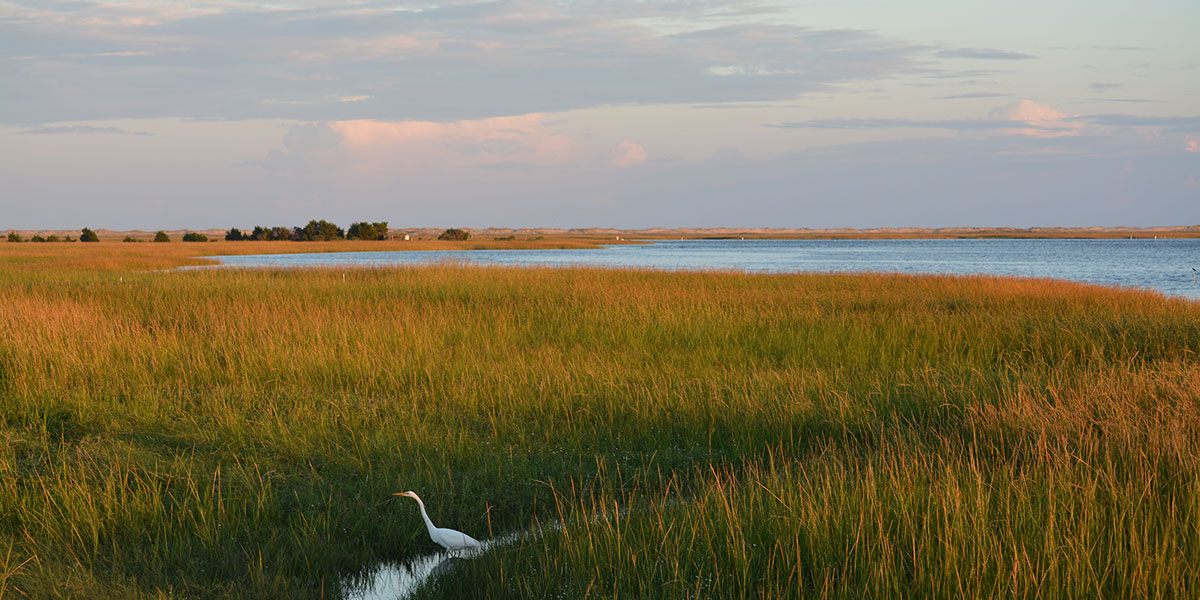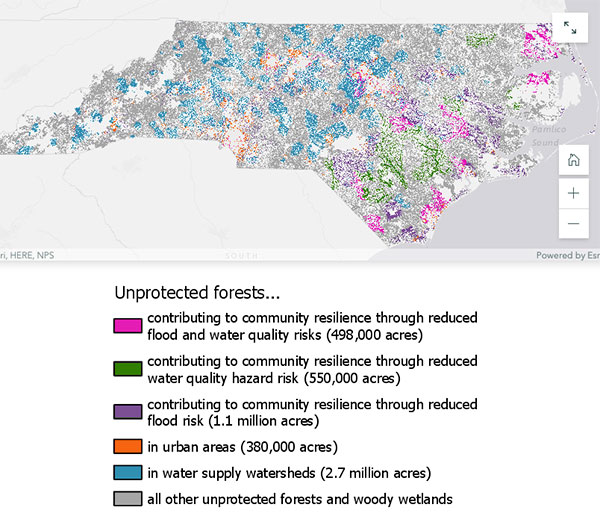North Carolina’s Path to Climate Resilience and a Clean Energy Economy: Three Stories of Policy Progress on Executive Order 80

By Joanna Parkman
In October 2018, North Carolina Governor Roy Cooper issued Executive Order 80, a commitment to tackle climate change and build a clean energy economy. Most notably, the directive included an economy-wide target of reducing greenhouse gas emissions by 40 percent below 2005 levels by 2025. Since then, the state has made steady progress in evaluating climate mitigation and adaptation practices, engaging diverse stakeholders, and developing an effective policy framework for reducing greenhouse gas emissions and enhancing resilience.
In late 2019, the North Carolina Department of Environmental Quality (DEQ) published the Clean Energy Plan to facilitate the use of clean energy resources and the development of a resilient electric grid across the state. The plan establishes an overall goal of reducing power sector greenhouse gas emissions by 70 percent below 2005 levels by 2030 and achieving carbon neutrality by 2050. Following this set of recommendations, DEQ released the North Carolina Climate Risk Assessment and Resilience Plan, the state’s first climate adaptation plan, on June 17 of this year.
To realize these goals, experts from Duke University’s Nicholas Institute for Environmental Policy Solutions are working in partnership with state agencies, environmental nonprofits, utility commissions, and other stakeholders to develop policies that aim to fund clean energy, enhance carbon storage opportunities on natural and working lands, and reduce power sector emissions.

Clean Energy Fund
As the COVID-19 pandemic has laid bare in recent months, North Carolinians face challenges of widespread unemployment, racial inequity, and the ongoing climate crisis. A state clean energy fund, or “green bank,” could be designed to address all of these challenges by driving greater capital into clean energy projects, reducing greenhouse gas emissions and stimulating economic development and job growth.
Spurred by Executive Order 80, three separate stakeholder processes—the Clean Energy Plan, the Energy Efficiency Roadmap, and the Department of Transportation’s Zero Emission Vehicle (ZEV) Plan—have recommended that the state consider implementing a clean energy fund, given these potential benefits.
In fall 2019, the Coalition for Green Capital (CGC), a national leader in creating and funding green bank institutions, announced a partnership with the Nicholas Institute's Climate and Energy Program to assess how establishing a North Carolina Clean Energy Fund based on a green bank model could provide North Carolinians with jobs and incentivize investment in clean and efficient energy solutions. The two groups facilitated discussions with diverse stakeholders from across the state to illuminate clean energy finance opportunities and identify barriers to access—especially for vulnerable populations—that a Clean Energy Fund could overcome.
Using clean energy financing mechanisms, a green bank would offer two main benefits for North Carolinians: job creation and greenhouse gas emission reduction. But the Clean Energy Fund would fill numerous other roles as well, connecting market participants with expertise and information, reducing risks to private lenders, and bundling smaller projects as part of a larger portfolio.
Equitable access to clean energy has become a priority for North Carolina, and this mission-driven model could improve accessibility by helping residents understand the benefits of renewable energy and energy efficiency, while providing risk mitigation tools to private investors.
– Jennifer Weiss, Nicholas Institute for Environmental Policy Solutions
"The North Carolina Clean Energy Fund would offer financing to populations that might not always have these opportunities available," said project lead Jennifer Weiss, a Nicholas Institute senior policy associate. “This kind of model would grant security, in the form of credit enhancements, to private lenders who might not normally lend to low-income households. Lots of people can get loans for solar right now, but the Clean Energy Fund will ensure that low-interest financing is accessible to all.”
For end consumers, a green bank model doesn’t operate much differently than a regular bank, in terms of providing low-interest loans. But Weiss cautions that in most cases, the similarities end there. After all, green banks aren’t regulated like traditional banks and do not accept deposits. Plus, green banks offer additional educational and technical assistance opportunities which traditional banks generally do not.
States such as Connecticut and New York have implemented quasi-public green banks with various governance structures on the state level. Given the budgetary and political realities in North Carolina, the Clean Energy Fund would likely take a different form.
“While green banks can be legislatively mandated, that approach doesn’t work in certain political landscapes,” said Weiss. “A nonprofit model is increasingly used and can be established on its own, separate from the state, or include state executives on its board.”
The Nicholas Institute and CGC intend to release the Clean Energy Fund draft feasibility report in September and continue pursuing discussions with prospective funders.
“Green banks aren’t designed to do just one or two things,” Weiss said. “They’re flexible in filling market gaps and can move into new areas.”
With this adaptive framework in place, there may even be a resilience component to the project in the future. At the moment, however, Weiss believes the North Carolina Clean Energy Fund would be a “win-win in terms of producing clean energy and putting people back to work safely.”

Natural and Working Lands Action Plan
From the Blue Ridge Mountains to the Outer Banks, many of North Carolina’s most distinctive landscapes include forests, wetlands, and farms. These natural and working lands (NWL) collectively make up 88 percent of the state, or 27.4 million acres, and contribute roughly 20 percent of Gross State Product.
As part of North Carolina’s efforts to address both the causes and effects of climate change, DEQ published the North Carolina Natural and Working Lands Action Plan within the broader North Carolina Climate Risk Assessment and Resilience Plan. The 25 recommendations for nature-based solutions outlined in the action plan stemmed from extensive stakeholder engagement involving experts across state government, academic institutions, and NGOs.
Throughout this process, Nicholas Institute Ecosystem Services Program Director Lydia Olander and Policy Associate Katie Warnell led a subcommittee on floodplains and wetlands to identify priorities for protection and restoration. Using publicly available data, Olander and Warnell also developed an interactive ArcGIS StoryMap ![]() highlighting where natural and working land protection and restoration efforts can be implemented for forests, floodplains, and coastal habitats to identify areas that offer maximum co-benefits.
highlighting where natural and working land protection and restoration efforts can be implemented for forests, floodplains, and coastal habitats to identify areas that offer maximum co-benefits.
“The StoryMap enables us to assess the scale of opportunities across the landscape where natural and working lands provide both carbon storage and improved community resilience,” Olander said. “It can also be used to target conservation and restoration to those areas which provide the broadest suite of benefits.”
The maps show where opportunities exist across the state to implement many of the action plan’s recommendations on the ground, Warnell explained.
“A lot of the maps are focused on looking at additional benefits that we can get from these actions—so thinking beyond just carbon benefits to things like enhancing community resilience to flooding, protecting the quality of our drinking water supplies, and enhancing air quality in urban areas,” she added.
While the state working group was originally convened to focus on natural climate solutions, “After hurricanes Florence and Matthew hit North Carolina in 2018, we began exploring resilience opportunities and areas where this overlapped with carbon storage — including blue carbon and forests in wetlands and floodplains,” Olander said.
In the end, the report focused on five core goals generated by stakeholders that center on greenhouse gas emissions mitigation, ecosystem and community resilience, public health, economic opportunities, and social equity.
Forests and coastal habitats were identified as a high priority by the group. Because forests cover 42 percent of North Carolina’s land and store 36 times more carbon than the state emits in a year, these ecosystems will be central to any strategy for achieving state climate goals. Partnerships with private landowners, who own the vast majority of forests in North Carolina, will be necessary to achieve move forward. As a result, it will also be important to find ways to incentivize improved forest management, conservation, and reforestation through both market opportunities associated with forest products and carbon offsets and federal and state programs.
While coastal wetlands may not offer as much carbon storage and sequestration, they provide critical protection from storms by retaining water and mitigating flooding. They also serve as important nurseries for the state’s fisheries and provide recreational opportunities, critical components of the coastal economy.
Considering NOAA’s forecast for “an above-normal 2020 Atlantic hurricane season,” the North Carolina Natural and Working Lands Action Plan couldn’t be more timely.

Power Sector Carbon Policies
If North Carolina is to meet economy-wide emissions targets under Executive Order 80, one of the state’s largest emitters—the power sector—must play a key role.
The 2019 Clean Energy Plan takes this challenge even further by specifically calling for development of carbon policy recommendations that prioritize greenhouse gas emission reductions, electricity affordability, and grid reliability. As suggested by its name, the forthcoming Power Sector Carbon Policy Plan focuses on electricity producers, who have historically been major emitters.
Climate and Energy Program Director Kate Konschink and Nicholas Institute alum Jonas Monast, director of the UNC School of Law’s Center on Climate, Energy, Environment & Economics, have been actively developing the framework for a North Carolina Power Sector Carbon Policy Plan since December 2019. Konschink and Monast are leading a group of stakeholders through a process to identify, define, and model the outcomes of different decarbonization policies, work that must be submitted to Governor Cooper by the end of the calendar year.
Throughout the research and drafting stages of the Power Sector Carbon Policy Plan, a stakeholder process has remained central. More than 80 stakeholders representing different constituencies across the state have informed the plan’s trajectory, including those from investor-owned utilities, rural co-ops, the Governor’s Office, DEQ, the North Carolina Utilities Commission, NGOs, and industrial manufacturers.
While these diverse groups may not fully agree on all elements of the policies that are ultimately proposed, facilitators are prioritizing transparency and discussion.
“Because this isn’t a public regulatory process, we are working alongside groups, hoping to get stakeholders representing different voices across the state to build trust among each other,” Konschnik said. “Rather than trying to achieve consensus, the primary aim is to ensure the participants feel like they are being heard and having their concerns addressed.”
Two stated core values for the Power Sector Carbon Policy Plan—affordable electricity and a reliable grid—are meant to address stakeholder concerns while putting the state on a path toward a clean energy future that benefits all North Carolinians.
“People know where they’re currently at with the cost and reliability of their energy sources,” Konschnik said. “Especially in light of the recent economic downturn and COVID-19, low-income communities and industry may be concerned about having access to affordable, competitive electricity bills. It’s essential that we move forward in an equitable way.”
Despite the challenges posed by COVID-19, the drafting group remains on track to deliver the Power Sector Carbon Policy Plan report by December. It plans to host a future presentation that focuses on the modeling included in the report.
"The hope is that this report shows that there are practical and cost-effective ways to clean up the grid, mitigate climate change impacts in North Carolina, and drive new economic development for the state," Konschnik said.
– Kate Konschnik, Nicholas Institute for Environmental Policy Solutions




